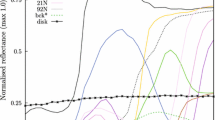Abstract
Most species of flower-visiting Hymenoptera are trichromatic, with photoreceptor spectral sensitivity peaks in the UV, blue and green regions of the spectrum. Red flowers, therefore, should be relatively difficult to detect for such insects. Nevertheless, in population biological studies in the bumblebee, Bombus terrestris, the Sardinian island population (B. t. sassaricus) displayed significantly higher responses to red artificial flowers (in tests of innate colour choice and detectability) than several mainland populations of the same species (Chittka et al. in Cognitive ecology of pollination, pp 106–126, 2001; Popul Ecol 46:243–251, 2004). Since there is relatively little physiological data on population differences in sensory systems, we used intracellular recording to compare photoreceptor spectral sensitivity in B. t. sassaricus and the southern European and Mediterranean population, B. t. dalmatinus. The results show both populations to be UV–blue–green trichromats, but with a small but significant increase in long-wave sensitivity in island bees. Spectral peaks were estimated at 348, 435 and 533 nm (B. t. dalmatinus) and 347, 436 and 538 nm (B. t. sassaricus) for UV, blue and green receptors, respectively. There were no significant differences in UV and blue receptor sensitivities. We found no photoreceptors maximally sensitive to red spectral light in the Sardinian population and model calculations indicate that the behavioural population differences in colour responses cannot be directly explained by receptor population differences.





Similar content being viewed by others
Explore related subjects
Discover the latest articles and news from researchers in related subjects, suggested using machine learning.References
Arikawa K, Stavenga DG (1997) Random array of colour filters in the eyes of butterflies. J Exp Biol 200:2501–2506
Autrum HJ, Zwehl Vv (1964) Die spektrale Empfindlichkeit einzelner Sehzellen des Bienenauges. Z Vergl Physiol 48:357–384
Backhaus W, Menzel R (1987) Color distance derived from a receptor model of color vision in the honeybee. Biol Cybern 55:321–331
Briscoe AD, Chittka L (2001) The evolution of color vision in insects. Annu Rev Entomol 46:471–510
Chittka L (1992) The colour hexagon: a chromaticity diagram based on photoreceptor excitations as a generalized representation of colour opponency. J Comp Physiol A 170:533–543
Chittka L, Ings TC, Raine NE (2004) Chance and adaptation in the evolution of island bumblebee behaviour. Popul Ecol 46:243–251
Chittka L, Spaethe J, Schmidt A, Hickelsberger A (2001) Adaptation, constraint, and chance in the evolution of flower color and pollinator color vision. In: Chittka L, Thomson JD (eds) Cognitive ecology of pollination, University Press, Cambridge, pp 106–126
DeVoe RD, de Souza JM, Ventura DF (1997) Electrophysiological measurements of spectral sensitivities: a review. Braz J Med Biol Res 30:169–177
Giurfa M, Zaccardi G, Vorobyev M (1999) How bees detect coloured targets using different regions of their compound eyes. J Comp Physiol A 185:591–600
Laughlin SB (1981) Neural principles in the peripheral visual systems of invertebrates. In: Autrum H (ed) Vision in invertebrates. Handbook of sensory physiology, vol VII/6B. Springer, Berlin, pp 133–280
Menzel R (1979) Spectral sensitivity and colour vision in invertebrates. In: Autrum H (ed) Invertebrate photoreceptors. Handbook of sensory physiology, vol VII/6A. Springer, Berlin, pp 503–580
Menzel R, Blakers M (1976) Color receptors in bee eye—morphology and spectral sensitivity. J Comp Physiol A 108:11–33
Menzel R, Steinmann E, de Souza J, Backhaus W (1988) Spectral sensitivity of photoreceptors and color-vision in the solitary bee, Osmia rufa. J Exp Biol 136:35–52
Menzel R, Ventura DF, Hertel H, de Souza JM, Greggers U (1986) Spectral sensitivity of photoreceptors in insect compound eyes: comparison of species and methods. J Comp Physiol A 158:165–177
Merbs SL, Nathans J (1992) Absorption spectra of human cone pigments. Nature 356:433–435
Meyer-Rochow VB (1980) Electrophysiologically determined spectral efficiencies of the compound eye and median ocellus in the bumblebee Bombus hortorum tarhakimalainen (Hymenoptera, insecta). J Comp Physiol A 139:261–266
Naka KI, Rushton WAH (1966) An attempt to analyse colour reception by electrophysiology. J Physiol (Lond) 185:556–586
Peitsch D, Fietz A, Hertel H, de Souza J, Ventura DF, Menzel R (1992) The spectral input systems of hymenopteran insects and their receptor-based colour vision. J Comp Physiol A 170:23–40
Spaethe J, Briscoe AD (2005) Molecular characterization and expression of the UV opsin in bumblebees: three ommatidial subtypes in the retina and a new photoreceptor organ in the lamina. J Exp Biol 208:2347–2361
Stavenga DG (2002) Colour in the eyes of insects. J Comp Physiol A 188:337–348
Stavenga DG, Smits RP, Hoenders BJ (1993) Simple exponential functions describing the absorbance bands of visual pigment spectra. Vision Res 33:1011–1017
Wakakuwa M, Kurasawa M, Giurfa M, Arikawa K (2005) Spectral heterogeneity of honeybee ommatidia. Naturwissenschaften 92:464–467
Wakakuwa M, Stavenga DG, Kurasawa M, Arikawa K (2004) A unique visual pigment expressed in green, red and deep-red receptors in the eye of the small white butterfly, Pieris rapae crucivora. J Exp Biol 207:2803–2810
Wyszecki G, Stiles WS (1982) Color science: concepts and methods, quantitative data and formulae. Wiley, New York
Acknowledgments
We thank Simon Laughlin for essential advice on constructing the visual electrophysiology set-up. This work was supported by NERC (UK) Research Grant NER/B/S/2003/00281 to LC and PS. TFD was supported by the Post-Doc Program of the German Academic Exchange Service.
Author information
Authors and Affiliations
Corresponding author
Electronic supplementary material
Below is the link to the electronic supplementary material.
359_2006_206_MOESM1_ESM.doc
Electronic supplementary material 1. Relative spectral sensitivities of UV, blue and green receptors of B. t. dalmatinus and B. t. sassaricus. Sensitivity was calculated in 4 nm steps after fitting exponential templates of the form described by Stavenga et al. (1993) to the normalized, electrophysiologically-measured sensitivity data for each receptor class from each population. (DOC 220 kb)
Rights and permissions
About this article
Cite this article
Skorupski, P., Döring, T.F. & Chittka, L. Photoreceptor spectral sensitivity in island and mainland populations of the bumblebee, Bombus terrestris . J Comp Physiol A 193, 485–494 (2007). https://doi.org/10.1007/s00359-006-0206-6
Received:
Revised:
Accepted:
Published:
Issue Date:
DOI: https://doi.org/10.1007/s00359-006-0206-6




